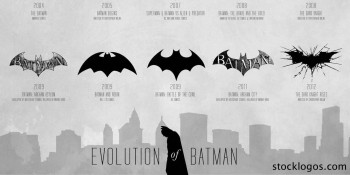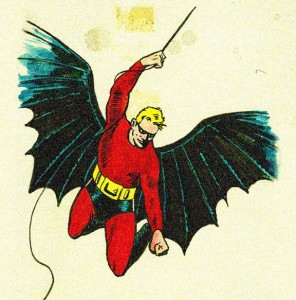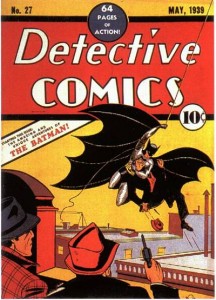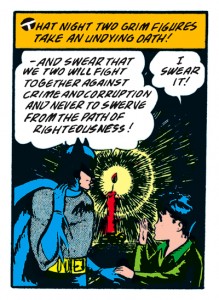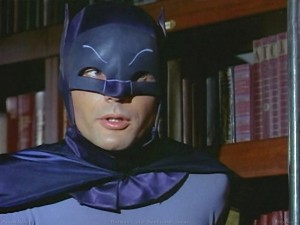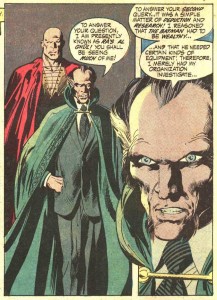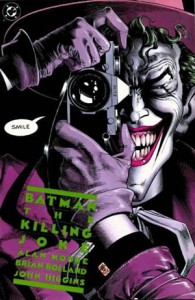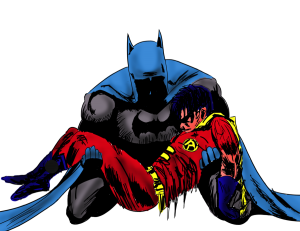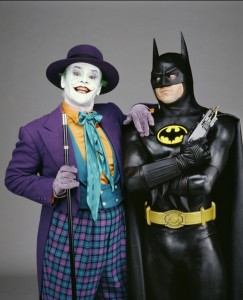When it comes to iconic American characters, there can be no doubt that Batman is among the best. Created in 1939, “the Batman” has endured across seven and a half decades of vast social change, surviving innumerable reboots and interpretations to become a fascinating, well-crafted character who is both relatable and legendary.
Fans of Batman have always appreciated the character for being remarkably unique. The Dark Knight, however, began as a ripoff of every character his creator had ever heard of.
Origins of the Bat-Man
The idea for a the vigilante hero came about as a money-making scheme. Bob Kane, a comic book artist at the time, was looking to make the same kind of money as Superman creators Jerry Siegel and Joe Shuster. Kane promised to bring National Periodicals, today’s DC Comics, a new superhero to publish alongside the Man of Tomorrow.
Kane began sketching his ideas for a Bat-Man, drawing a character similar to Superman, in a bright red suit, but with wings like a bat. Kane took his proposal to his writer friend, Bill Finger, who offered ideas to modify the outfit for the bat-themed hero. Finger proposed getting rid of the domino mask and replacing it with Batman’s signature cowl to give the hero the appearance of his namesake mammal. Instead of large wings, Batman would wear a cape that could be made to simulate the appearance of wings. Finger also suggested that Kane replace the red suit that was too similar to Superman’s bright colors with darker shades befitting a nighttime vigilante.
Despite his contributions, Finger never received much recognition in his lifetime, and is largely viewed as the uncredited co-creator of Batman.
Under Kane and Finger’s direction, Batman began to take on traits of several popular characters. Kane often cited being inspired by The Scarlet Pimpernel, the swashbuckling Zorro, and Leonardo da Vinci’s flying machine. Kane and Finger have also acknowledged the heavy influences of The Phantom, Doc Savage, The Shadow, and Sherlock Holmes. The Bat-Man made his debut in Detective Comics #27 in “The Case of the Chemical Syndicate.”
Developing the Story
To explain why a millionaire like Bruce Wayne would dress in a bat costume to fight crime in dark alleys, the writers concocted a tragic story that would traumatize any young boy. The story has remained almost exactly the same across numerous genres and retellings.
As presented in Detective Comics #33, young Bruce Wayne witnessed the cold-blooded murder of both his mother and father after a trip to the theater. The shock of this senseless crime caused the boy to make a vow. He would not only swear vengeance against the criminal who killed his parents, but against crime itself. It is this vow, even more than the death of his parents, that is the central tragedy of the Batman mythology.
Almost immediately, the Caped Crusader’s supporting cast filled out. Commissioner Gordon, Batman’s liaison in the Gotham City Police Department, was introduced in the same issue as the Dark Knight himself. The character has endured across the ages as another Gotham hero, including his most recent portrayal on film by Gary Oldman.
Only a year into his run as a hero, Batman took on a sidekick, sparking a new trend in comics of underage boys fighting monsters and dangerous criminals. Robin was introduced as a writing device, decreasing the number of thought balloons on a given page by giving Bruce a friend with whom to discuss his plans.
The Boy Wonder became an adopted son to the chronically lonely Bruce Wayne, adding a new layer to Batman’s character. Dick Grayson, the original Robin, evolved over the years into a hero in his own right, called Nightwing, creating a second iconic character out of the Bat mythos.
The Dark Side of the Dark Knight
In the early years, Batman was not opposed to killing or simply letting his opponents die. Longtime fans of the Bat would be aghast to see their hero breaking necks of bad guys and firing a gun when necessary.
In Batman #1, which saw the introduction of perennial villains The Joker and Catwoman, Wayne used guns to slay monstrous giants. The violent imagery led the editor to decree the end of guns and killing in the Bat comics. Bruce Wayne’s aversion to firearms and killing was retconned, explained as stemming from the loss of his parents. Batman’s refusal to kill has become one of his most defining traits.
The desire to make money and gain notoriety almost killed Batman in the same way that led to his creation. In 1954, Seduction of the Innocent by Fredric Wertham linked teenage delinquency to comic books, usually citing the violent and gruesome nature and imagery of horror comics.
As expected, the sensational book, which offered little in the way of verifiable science, sparked an outcry exaggerated by a politician looking for an issue to get his name in the news. Estes Kefauver was a Democrat with his eye on the Presidential nomination. Seduction of the Innocent would give him his issue and his media attention.
While Kefauver never became President of the United States, he did force the comic book industry to create a self-censoring body known as the Comics Code Authority. The CCA established numerous rules which led to the death of innumerable superhero properties and forced change upon those that survived.
Batman became a deputy of the Gotham Police Force who fought crime in the daytime. His stories took on elements of the fanciful and the science fiction genre. DC introduced new characters into the Bat mythos, Batwoman and an early version of Batgirl, likely to curb Wertham’s charges of homosexuality in the Bat world.
Entering a new medium
By 1966, Batman comics were close to cancelation. Swooping in at the last second to save the day, the ABC television network picked up the Batman character for a new TV series. Batman, starring Adam West and Burt Ward, became a national sensation, offering a campy take on the character that was actually quite faithful to the comics of the time. The show employed a brilliant tactic: appeal to audiences of all ages. For the kids, Batman was a serious adventure story about the Caped Crusader. To adults, it was a humorous take on the absurdist nature of the superhero genre.
Unfortunately for Bat-fans, the show only lasted three years before being canceled due to declining ratings. Still, the show has had an enduring impact, being referenced to this day: Adam West regularly makes appearances to parody his most famous role in shows such as Family Guy and The Fairly Oddparents.
Batman on TV created a new generation of fans, but for some dedicated to the franchise, the hero portrayed on ABC was no Dark Knight. Comic book writers and artists did not want to see another generation of fans grow up believing that Batman was the goofy master of onomatopoeia.
Artist Neal Adams and writer Denny O’Neil led the charge, taking over the Batman comics in 1969. Looking to add real-world issues into the formerly extravagant comic, Adams and O’Neil introduced the terrorist character Ra’s al Ghul. Ra’s represented a change in Batman stories from exclusively flamboyant supervillains with increasingly convoluted evil plots, to more realistic stories and more relatable villains. Unlike the numerous Bat-villains that preceded him, Ra’s aimed for a seemingly noble goal. He wished to save the world’s environment. The only problem: it would require the death of humanity.
Despite these changes, Batman comics continued to decrease in sales until 1986, when a bold new writer, known for his dark work on Marvel’s Daredevil, was given the opportunity to write the definitive Batman story.
The Bleak Reality
The Dark Knight Returns by Frank Miller tells the story of a 55-year-old Batman, 10 years after retiring, returning to his crusade against crime in a Reagan-Era Gotham City. Miller’s Batman is, in several ways, a departure from the Batman of mercy, born of his parents’ tragic murder. Instead, Batman is a terrifying brute, certain of what is right and willing to permanently injure those in the wrong.
Batman, in The Dark Knight Returns by Frank Miller
This Dark Knight appears to have a death wish, constantly challenging himself to greater fights, until finally the Batman takes on a stand-in for God himself: Superman. In Miller’s bleak reality, Ronald Reagan nearly sparks nuclear war. With Superman by his side, the president believes the United States to be invincible, and he is willing to use its power belligerently, knowing that the Man of Steel is fast enough to stop a nuclear strike from the Soviet Union. As Reagan’s stooge, Superman is brought in to take down Batman. The Dark Knight, always prepared, welcomes Clark Kent’s arrival and enacts a plan to bring the Man of Tomorrow down.
Miller’s Batman defined the hero for a generation as a brutal, unforgiving, genius man, capable of striking fear into the gods themselves.
Following the success of Dark Knight Returns, Miller was asked to rewrite the origin story of the Caped Crusader. Setting his story in a Gotham City controlled by organized crime, Batman: Year One follows the early years of Gordon in the GCPD and Wayne’s attempts to become greater than just a man. Year One asks a question later addressed in the Christopher Nolan film trilogy: Is Batman to blame for the rise in theatrical supervillains?
Adding a new dimension to the Batman character was Alan Moore and his classic work The Killing Joke. That installment follows the Joker’s attempts to corrupt Batman and Gordon. Joker is meant to act as the mirror image of the Dark Knight, a man who was changed by only “one bad day.” In an attempt to prove that one bad day is the only difference between men like Gordon and himself, the Joker sets out to ruin the Commissioner’s life by shooting and torturing his daughter, Barbara Gordon.
The Killing Joke is one of the most philosophically challenging Batman stories ever written. Is Batman, by not killing the Joker, responsible for the deaths the Joker causes? Since the editorial decision following Batman #1, the Gotham City hero has been known for his deontological stance on killing. Moore had the Joker challenge Bruce Wayne’s convictions, and some fans believe the Joker was actually successful in breaking Batman’s will.
Batman stories continued through the realm of darkness, culminating in a showcase of the danger of kids fighting crime. In A Death in the Family, the second man to don the Robin costume, Jason Todd, is beaten to the point of death by the Joker. The decision about Todd’s fate was left up to fans of the Batman comics, and they chose to allow Todd to die.
On to the Silver Screen
In 1989, the Bat achieved new levels of popularity with the release of Tim Burton’s Batman movie. Inspired by The Killing Joke, Burton’s Batman is a single-minded crusader who is often aloof when not seeking out Gotham’s criminals. Burton and actor Michael Keaton returned to Gotham City with Batman Returns. This second installment in the series saw a much more absurdist city, perhaps changed by the appearance of the Batman and the Joker. After Burton left the series, Warner Brothers continued the franchise by handing over the reins to Joel Schumacher. These movies are so universally panned that it’s better just to say nothing.
In 2005, Batman returned to the big screen under the direction of Christopher Nolan. Batman Begins drew its inspiration from Year One, retelling the famous origin story of the Caped Crusader while adding chapters about his time spent traveling the globe to acquire the skills necessary for an urban war.
Following the success of Batman Begins, Warner Brothers released The Dark Knight, starring a returning Christian Bale as the title character, with Heath Ledger redefining the Joker. Ledger’s portrayal of the maniacal clown earned universal praise and a posthumous Academy Award. The Dark Knight and its sequel are currently among the highest grossing films of all time.
The Joker, in The Dark Knight Returns by Frank Miller
Batman can be found in dozens of ongoing DC comics and is returning to theaters in 2016’s tentatively titled Batman vs. Superman.
An Enduring Legacy
Batman has become a cornerstone of American culture. With successful movies and comics, an upcoming television show based on Gotham City, and 75 years of mythology to draw from and build on, the Dark Knight will likely be with us for a long time.
Bruce Wayne, as a man among gods, inspires us to achieve greatness. Despite being only human, Batman has faced down the likes of alien demigods Superman and Darkseid and has always come out on top. Batman reminds us of the strength of one person to do tremendous good.
And if you ever doubt the inspiring nature of Gotham’s greatest hero, just remember the Batkid.
All Batman comics are the property of DC Comics. Thank you to comicvine.com for archiving these images.
The author recommends the following resources for more information on Batman:
Batman and Psychology
Batman and Philosophy
Batman: Year One
The Long Halloween
Death in the Family
The Killing Joke
Hush
The Dark Knight Returns
